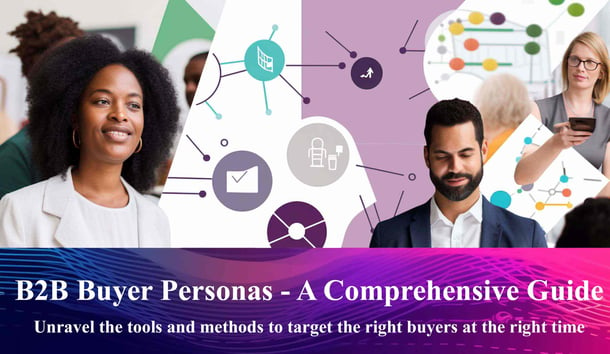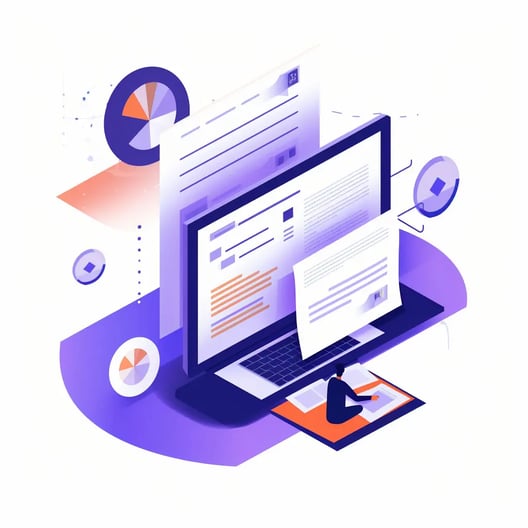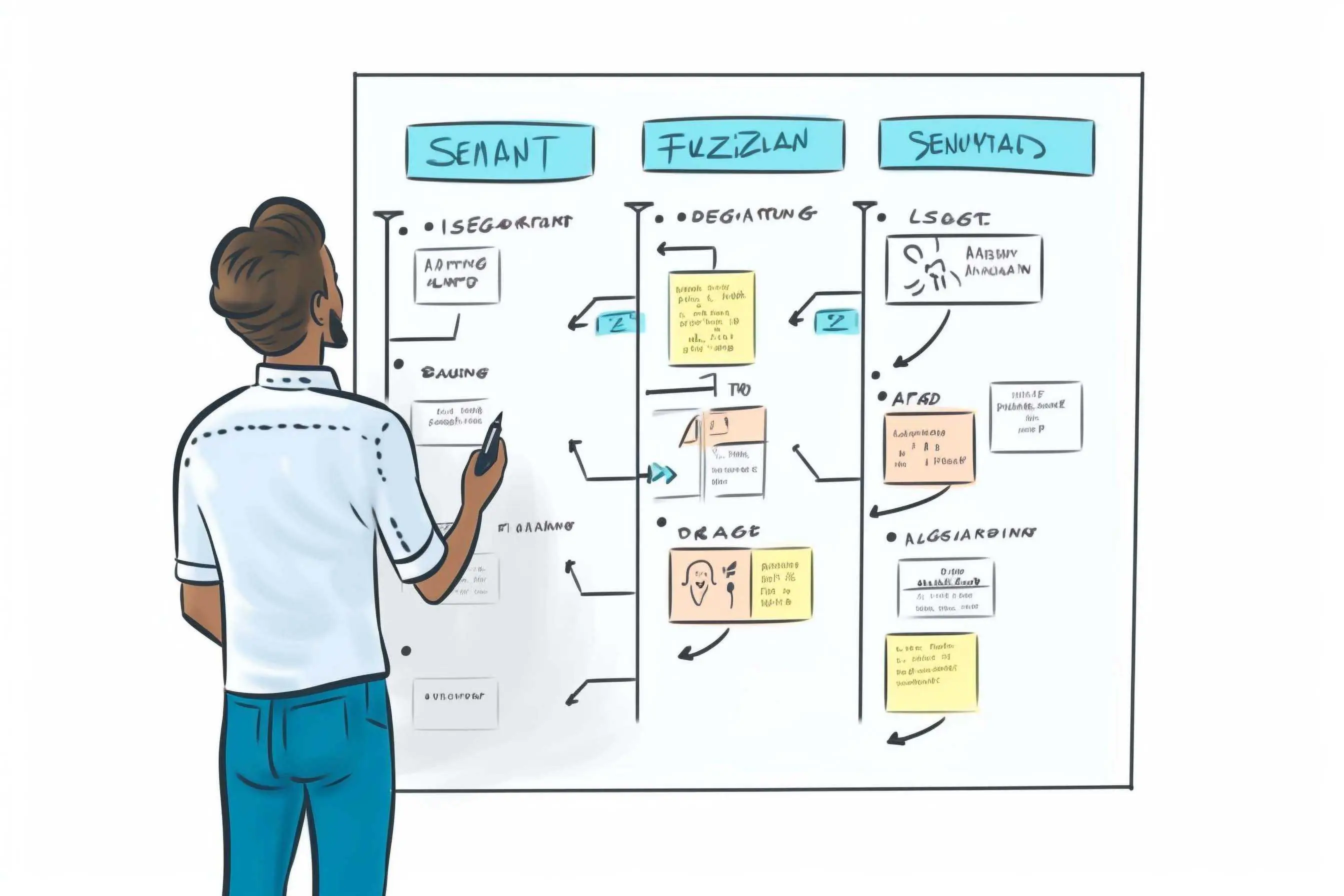Understanding and catering to your target audience is essential for success. This guide aims to help you grasp the importance of B2B target personas and equip you with the necessary tools and knowledge to create and implement them effectively.
Table of Contents:
1. Introduction
2. Understanding B2B Target Personas
3. Research and Data Gathering
4. Identifying Key B2B Persona Attributes
5. Creating B2B Target Personas
6. Segmenting and Prioritizing B2B Target Personas
7. Integrating Personas into Marketing and Sales Strategies
8. Measuring and Optimizing B2B Target Persona Strategies
10. Case Studies and Best Practices
11. Conclusion

1. Introduction
Buyer Personas - What are they?
B2B target personas are semi-fictional representations of your ideal customers, created by aggregating and analyzing data and insights from multiple sources. These personas enable you to visualize and empathize with the people you aim to serve, helping you create more tailored and relevant marketing and sales strategies.
Why are they Significant?
The significance of B2B target personas cannot be overstated. By understanding your audience's demographics, firmographics, psychographics, and behavioral traits, you can create targeted messaging that resonates with them, leading to improved conversion rates, increased customer satisfaction, and ultimately, business growth.
In this guide, we will explore the various aspects of B2B target personas, including research and data gathering, persona attributes, creation, segmentation, and integration into marketing and sales strategies. Additionally, we will discuss the tools and technologies available to help you execute and measure persona-driven campaigns, as well as share case studies and best practices from successful companies. So let's dive in and unlock the potential of B2B target personas for your business!
.webp?width=2688&height=1792&name=A%20grid%20of%20six%20stylized%20email%20templates%20each%20representing%20(3).webp)
2. Understanding B2B Target Personas
In this section, we will delve into the concept of B2B target personas, discussing their definition, role in B2B marketing, differences compared to B2C personas, and the benefits of using them in marketing and sales initiatives.
2.1 Definition and Role of Target Personas in B2B Marketing
A target persona, also known as a buyer persona or customer persona, is a semi-fictional representation of your ideal customer based on real data and research. These personas help marketers, salespeople, and other stakeholders to visualize and empathize with their target audience, enabling them to make informed decisions when crafting marketing and sales strategies.
In B2B marketing, target personas are especially crucial, as businesses often serve diverse clients with varying needs, preferences, and decision-making processes. B2B target personas provide a framework for understanding the unique characteristics, challenges, and goals of these clients, allowing businesses to develop tailored messaging and solutions that resonate with their audience.
2.2 Differences between B2B and B2C Personas
While both B2B and B2C personas aim to encapsulate the characteristics of their respective target audiences, there are some key differences between the two:
- Decision-making process: B2B personas typically reflect a more complex decision-making process, as multiple stakeholders are often involved in the purchase decision. B2C personas, on the other hand, generally represent individual consumers making decisions based on personal preferences.
- Firmographics: B2B personas often include firmographic data, such as company size, industry, revenue, and location. This information is critical for understanding the context and needs of the businesses you're targeting. B2C personas usually focus more on demographic and psychographic attributes, as well as consumer behavior patterns.
- Relationship and sales cycle: B2B relationships tend to be longer-term, with a more extended sales cycle compared to B2C. As a result, B2B personas should incorporate information on the buyer's journey and the various touchpoints that influence their decision-making process. B2C personas, while still considering the buyer's journey, usually involve shorter sales cycles and a more immediate focus on consumer needs and desires.
- Goals and challenges: B2B personas often emphasize the professional goals, challenges, and pain points of their target audience, as businesses seek solutions to enhance their operations, increase efficiency, or solve specific problems. B2C personas, in contrast, tend to focus on personal aspirations, motivations, and lifestyle preferences.
2.3 Benefits of Using Target Personas in Marketing and Sales
Implementing B2B target personas in your marketing and sales strategies can yield numerous benefits for your organization, including:
- Improved messaging: By understanding the unique attributes and preferences of your target audience, you can craft tailored messaging that resonates with them, leading to increased engagement and conversion rates.
- Enhanced customer-centricity: Personas encourage an organization-wide focus on the customer, fostering a more customer-centrist culture that prioritizes the needs and desires of your audience.
- Better product and service development: Understanding your target personas can help inform product and service development decisions, ensuring that you create solutions that truly address the needs of your audience.
- More effective marketing campaigns: Personas enable you to segment your audience and create targeted marketing campaigns that cater to the specific characteristics and preferences of each segment, leading to improved ROI and campaign performance
- Greater sales success: By providing sales teams with insights into the motivations, challenges, and decision-making processes of their target personas, they can tailor their pitches and proposals to better address the needs of potential clients, resulting in higher close rates and increased revenue.
- Efficient resource allocation: By focusing on the most relevant and high-priority target personas, businesses can allocate their resources more effectively, ensuring that marketing and sales efforts are directed toward the most valuable audience segments.
- Stronger brand positioning: Developing a deep understanding of your target personas enables you to create a brand narrative and positioning that aligns with their needs and aspirations, fostering long-term loyalty and advocacy.
Overall, incorporating B2B target personas into your marketing and sales strategies can significantly enhance your organization's ability to connect with its audience, leading to improved customer satisfaction, increased revenue, and sustained business growth.
In the upcoming sections, we will explore the various steps involved in researching, creating, and implementing B2B target personas, as well as discuss the tools and technologies available to support these efforts. Armed with this knowledge, you'll be well-equipped to harness the power of B2B target personas and elevate your organization's marketing and sales success..webp?width=760&height=507&name=A%20marketer%20creating%20a%20detailed%20customer%20persona%20on%20a%20whi%20(4).webp)
3. Research and Data Gathering
The foundation of any successful B2B target persona is thorough research and data gathering. In this section, we will explore various primary and secondary research methods, as well as discuss internal data sources that can be leveraged to create accurate and actionable personas.
3.1 Primary Research Methods
Primary research involves collecting new data directly from your target audience or stakeholders. Some common primary research methods include:
- Interviews: Conduct one-on-one interviews with existing customers, prospects, and even lost customers to gather insights into their needs, motivations, challenges, and preferences. This qualitative data can be invaluable for understanding the nuances of your target personas.
- Surveys: Design and distribute surveys to your customer base, prospects, or industry contacts to collect quantitative data on demographics, firmographics, preferences, and other relevant attributes. Surveys can provide a broader view of your audience and help identify patterns and trends.
- Focus groups: Organize focus group discussions with a small, representative sample of your target audience to dive deeper into specific topics or issues. Focus groups can yield rich insights and facilitate a deeper understanding of the attitudes, values, and concerns of your audience.
3.2 Secondary Research Methods
Secondary research involves analyzing existing data and information from external sources. Some common secondary research methods include:
- Market reports: Leverage industry-specific market reports to gain insights into trends, market size, growth projections, and key players. These reports can provide valuable context for understanding your target personas' industry landscape.
- Industry publications: Review industry publications, blogs, and news articles to stay informed about the latest developments, challenges, and opportunities facing your target audience. This information can help you identify the pressing issues and concerns that may be affecting your target personas.
- Competitor analysis: Investigate your competitors' marketing and sales strategies to identify their target audience, messaging, and positioning. Understanding your competition can offer valuable insights into potential gaps in the market and opportunities to differentiate your offerings.
3.3 Internal Data Sources
In addition to primary and secondary research, your organization may already possess valuable data and insights that can contribute to the development of your B2B target personas. Some potential internal data sources include:
- CRM: Customer relationship management (CRM) systems can provide a wealth of information on your existing customers, such as demographics, firmographics, purchase history, and interactions with your organization. Analyzing this data can help you identify common characteristics and patterns among your customer base.
- Customer service records: Customer service interactions, such as support tickets, chat transcripts, and call logs, can offer insights into the common challenges, pain points, and needs of your customers. This information can be instrumental in understanding the issues your target personas are facing and how your products or services can address them.
- Sales data: Analyzing sales data, such as deal sizes, sales cycle lengths, win/loss ratios, and reasons for wins and losses, can provide valuable insights into the factors that influence your target personas' decision-making process.
By combining data and insights from various primary and secondary research methods, as well as internal data sources, you can build a comprehensive picture of your target audience. This rich, multi-faceted understanding will serve as the foundation for creating accurate and actionable B2B target personas that truly reflect the unique characteristics, needs, and preferences of your ideal customers.
In the following sections, we will discuss how to identify key B2B persona attributes, create B2B target personas, segment and prioritize them, and integrate them into your marketing and sales strategies. By applying the knowledge and insights gained from your research and data-gathering efforts, you'll be well-prepared to develop and implement persona-driven strategies that resonate with your audience, resulting in improved engagement, conversion rates, and overall business growth.

4. Identifying Key B2B Persona Attributes
Once you've gathered data and insights from your research efforts, the next step is to identify the key attributes that define your B2B target personas. These attributes can be broadly categorized into demographics, firmographics, psychographics, and behavioral traits.
In this section, we'll discuss each of these categories and provide examples of attributes to consider when developing your personas.
4.1 Demographics
Demographic attributes pertain to the individual characteristics of the decision-makers or influencers within the organizations you're targeting. Some examples of demographic attributes include:
- Age
- Gender
- Location
- Education level
- Job title or role
- Years of experience
While demographics alone may not fully capture the complexity of your target personas, they can provide a useful starting point for understanding the people involved in the decision-making process
4.2 Firmographics
Firmographic attributes focus on the characteristics of the organizations your target personas represent. These attributes can help you better understand the context and needs of the businesses you're targeting. Some examples of firmographic attributes include:
- Company size (number of employees)
- Industry or sector
- Annual revenue
- Location
- Growth stage (start-up, established, etc.)
- Organizational structure
By considering firmographics, you can tailor your marketing and sales strategies to address the unique challenges and opportunities faced by businesses within specific industries or of certain sizes.
4.3 Psychographics
Psychographic attributes delve into the values, attitudes, goals, challenges, and pain points of your target personas. These attributes can offer a deeper understanding of what motivates your audience and how your products or services can help them achieve their objectives. Some examples of psychographic attributes include:
- Professional goals and aspirations
- Key challenges and pain points
- Decision-making criteria
- Values and attitudes towards industry trends or issues
- Preferred communication styles and channels
By incorporating psychographic attributes into your B2B target personas, you can create more personalized and empathetic messaging that truly resonates with your audience.
4.4 Behavioral Traits
Behavioral attributes encompass the actions and habits of your target personas, particularly as they relate to their purchasing behavior, decision-making process, and online activity. Some examples of behavioral attributes include:
- Purchasing behavior (e.g., preferred vendors, frequency of purchases, average order value)
- Decision-making process (e.g., length of the sales cycle, key decision-making stages, involvement of stakeholders)
- Online activity (e.g., preferred social media platforms, content consumption habits, website browsing behavior)
Understanding the behavioral patterns of your target personas can help you tailor your marketing and sales efforts to align with their preferences, leading to improved engagement and conversion rates.
By combining demographic, firmographic, psychographic, and behavioral attributes, you can create well-rounded and realistic B2B target personas that accurately represent your ideal customers.
Now we are ready to use these attributes to create, segment, and prioritize your target personas, as well as integrate them into your marketing and sales strategies. With a solid understanding of your audience's key attributes, you'll be well-equipped to develop persona-driven strategies that effectively address their unique needs and preferences, driving business growth and success.
5. Creating B2B Target Personas
With the key attributes identified, you're now ready to create your B2B target personas. In this section, we'll walk you through the step-by-step process for developing personas, provide tips for creating realistic and actionable personas, and share examples of well-crafted B2B personas.
5.1 Step-by-Step Process for Developing Personas
Analyze research and data: Review the data and insights gathered from your research efforts (primary, secondary, and internal sources) to identify common trends, patterns, and characteristics among your target audience.
Segment your audience: Based on your analysis, divide your audience into distinct segments based on shared attributes, such as demographics, firmographics, psychographics, and behavioral traits.
Choose representative segments: Select the most relevant and high-priority segments to serve as the basis for your target personas. These segments should represent the key audience groups that your organization aims to engage and serve.
Develop persona profiles: For each selected segment, create a detailed persona profile that includes a representative name, image, and a narrative that encapsulates the key attributes, motivations, challenges, and preferences of the persona. Ensure that your personas are specific, realistic, and relatable to facilitate empathy and understanding among your team members.
Validate your personas: Share your persona profiles with internal stakeholders, such as sales, marketing, and customer service teams, to gather feedback and ensure that they accurately reflect the experiences and insights of those who interact with your audience regularly.
Iterate and refine: Based on feedback and ongoing research, continually refine and update your target personas to ensure they remain relevant and accurate as your audience and market conditions evolve.
5.2 Tips for Creating Realistic and Actionable Personas
Be specific: Avoid generic descriptions and aim to create personas that are detailed and specific, as this will enable your team to better empathize with and understand the unique needs and preferences of your target audience.
Prioritize attributes: While it's important to cover a range of attributes, focus on the most critical characteristics that influence your audience's decision-making process and relationship with your organization.
Use real-world examples: Incorporate insights and anecdotes from your interviews, surveys, and focus groups to bring your personas to life and make them more relatable.
Align with business objectives: Ensure that your target personas align with your organization's overall business objectives and strategic priorities, as this will help guide your marketing and sales efforts more effectively.
Encourage collaboration: Involve stakeholders from across your organization in the persona development process to ensure that your personas are informed by diverse perspectives and experiences.
5.3 Examples of Well-Crafted B2B Personas
Example 1: "IT Manager Irene"
Demographics: 42-year-old female, bachelor's degree in computer science, 15 years of experience in IT management
Firmographics: Works for a mid-sized healthcare organization with 500 employees and $50 million in annual revenue
Psychographics: Values innovation and security, seeks cost-effective solutions to improve IT infrastructure, prefers clear and concise communication
Behavioral: Conducts thorough research before making purchase decisions, relies on industry publications and peer recommendations, active on LinkedIn for networking and knowledge sharing
Example 2: "CFO Chris"
Demographics: 52-year-old male, MBA in finance, 20 years of experience in financial management
Firmographics: Works for a manufacturing company with 1,000 employees and $200 million in annual revenue
Psychographics: Prioritizes financial stability and growth, seeks solutions that can streamline operations and reduce costs, appreciates data-driven insights and recommendations
Behavioral: Participates in the final decision-making process, values long-term vendor relationships, attends industry conferences and webinars for professional development
These examples illustrate how well-crafted B2B target personas can provide a comprehensive understanding of your audience's key attributes, motivations, and preferences, enabling your organization to develop more effective and targeted marketing and sales strategies.
Now we move on to explore how to segment and prioritize your B2B target personas and integrate them into your marketing and sales strategies to maximize their impact and drive business growth.

6. Segmenting and Prioritizing B2B Target Personas
With your B2B target personas created, the next step is to segment and prioritize them to ensure your marketing and sales efforts are focused on the most valuable audience groups.
In this section, we'll discuss the criteria for segmenting and prioritizing personas, outline strategies for addressing different target groups, and provide guidance on customizing content and messaging for each segment.
6.1 Criteria for Segmenting and Prioritizing Personas
To effectively segment and prioritize your target personas, consider the following criteria:
Revenue potential: Focus on personas that represent the highest revenue potential for your organization, taking into account factors such as deal size, customer lifetime value, and potential for upselling or cross-selling.
Alignment with business objectives: Prioritize personas that align with your organization's strategic goals, whether that means targeting specific industries, expanding into new markets, or increasing market share within existing segments.
Ease of acquisition: Evaluate the resources and effort required to acquire customers within each persona segment, and prioritize those that can be reached more easily or cost-effectively.
Competitive advantage: Consider your organization's unique strengths and differentiators when prioritizing personas, focusing on those where you have a clear competitive advantage or can offer a superior solution compared to your competitors.
6.2 Strategies for Addressing Different Target Groups
With your target personas segmented and prioritized, develop tailored strategies for addressing each group based on their unique characteristics, needs, and preferences:
Customized value propositions: Develop unique value propositions for each persona that emphasize the specific benefits and solutions your products or services can provide in addressing their pain points and challenges.
Personalized messaging: Craft messaging that speaks directly to each persona's motivations, goals, and preferences, ensuring that your communications resonate with them on a personal level.
Targeted content: Create content that addresses the specific interests, concerns, and information needs of each persona, such as blog posts, whitepapers, case studies, webinars, and videos.
Tailored marketing channels: Identify the marketing channels and platforms that are most relevant and effective for reaching each persona, and adjust your marketing mix accordingly.
6.3 Customizing Content and Messaging for Each Segment
To ensure your content and messaging are tailored to the unique needs and preferences of each target persona, consider the following tactics:
Segment-specific content themes: Develop content themes that address the specific interests, concerns, and challenges faced by each persona, and use these themes to guide your content creation efforts.
Personalized calls-to-action (CTAs): Design CTAs that align with the specific goals and motivations of each persona, encouraging them to take action in a way that resonates with their needs and preferences.
Customized email campaigns: Segment your email list based on persona attributes, and send targeted email campaigns with content and messaging tailored to each group.
Adapted social media content: Adjust your social media content strategy to reflect the preferences and habits of each persona, sharing content that appeals to their interests, engaging on platforms they frequent, and using hashtags or keywords that resonate with them.
By segmenting and prioritizing your B2B target personas and customizing your content and messaging accordingly, you can ensure that your marketing and sales efforts are focused on the most valuable audience segments and tailored to their unique needs and preferences. This targeted approach can lead to increased engagement, conversion rates, and overall business growth.
In the following sections, we will discuss how to integrate your target personas into your marketing and sales strategies, measure and optimize persona-based marketing efforts, and leverage tools and technologies to support your persona-driven campaigns. With a clear understanding of how to effectively segment and prioritize your B2B target personas, you'll be well-equipped to maximize the impact of your marketing and sales efforts and drive business success.
7. Integrating Personas into Marketing and Sales Strategies
To fully leverage the insights and value of your B2B target personas, it's essential to integrate them into your marketing and sales strategies. To do this, you will have to learn to incorporate personas into various aspects of your marketing and sales efforts, including content marketing, account-based marketing (ABM), email marketing, social media marketing, and sales enablement.
7.1 Content Marketing
Tailor your content marketing efforts to address the specific needs, preferences, and challenges of each persona by:
- Creating content that speaks directly to their pain points and offers solutions
- Developing a content mix that appeals to their content consumption habits, such as blog posts, infographics, webinars, or videos
- Utilizing keywords and topics that resonate with each persona to improve content discoverability and SEO performance
7.2 Account-Based Marketing (ABM)
Implement personalized ABM strategies that target key accounts represented by your personas by:
- Identifying high-value accounts that align with your target personas
- Developing customized marketing campaigns and sales outreach tailored to the unique needs and preferences of each account
- Leveraging insights from your personas to inform your account targeting, messaging, and content strategy
7.3 Email Marketing
Customize your email marketing campaigns for specific personas by:
- Segmenting your email list based on persona attributes
- Crafting personalized subject lines and email copy that resonate with each persona's motivations and interests
- Sending targeted content and offers that align with each persona's preferences and needs
7.4 Social Media Marketing
Select platforms and content types for your social media marketing efforts based on persona preferences by:
- Identifying the social media platforms where each persona is most active and engaged
- Sharing content that appeals to their interests and concerns, such as industry news, thought leadership pieces, or success stories
- Engaging with your audience through comments, direct messages, and community discussions to build relationships and foster trust
7.5 Sales Enablement
Provide your sales team with persona insights to improve pitches and proposals by:
- Sharing detailed persona profiles and insights with your sales team, enabling them to better understand the unique needs and motivations of each prospect
- Developing tailored sales collateral and presentations that speak directly to each persona's pain points, challenges, and decision-making criteria
- Offering sales training and coaching on how to effectively engage and communicate with different personas, ensuring that your sales team is equipped to build strong relationships and close deals
By integrating your B2B target personas into your marketing and sales strategies, you can create more targeted, personalized, and effective campaigns that resonate with your audience and drive business growth.
This persona-driven approach enables you to better understand and address the unique needs and preferences of your prospects and customers, fostering stronger relationships and increasing the likelihood of conversion and long-term loyalty.
In the following sections, we'll discuss how to measure and optimize your B2B target persona strategies, leverage tools and technologies to support your efforts, and explore case studies and best practices from companies that have successfully implemented persona-driven marketing and sales strategies. With a solid understanding of how to integrate your target personas into your marketing and sales efforts, you'll be well-positioned to maximize their impact and drive business success.
8. Measuring and Optimizing B2B Target Persona Strategies
To ensure the ongoing success and effectiveness of your persona-driven marketing and sales efforts, it's crucial to measure their performance and continuously optimize your strategies. In this section, we'll discuss the key performance indicators (KPIs) for evaluating persona-based marketing, share insights on analyzing and interpreting data to optimize your efforts, and explore A/B testing and experimentation as methods for refining persona strategies.
8.1 Key Performance Indicators (KPIs)
Track the success of your persona-based marketing efforts by monitoring relevant KPIs, such as:
- Conversion rates: Measure the percentage of prospects from each persona group that convert into leads or customers.
- Engagement metrics: Track engagement levels by persona, including metrics such as click-through rates, time on site, and content interactions.
- Lead quality: Assess the quality of leads generated from each persona by examining factors like lead-to-customer conversion rates and average deal size.
- Customer satisfaction: Monitor customer feedback and satisfaction scores by persona to understand how well your products or services are meeting their needs.
- Customer lifetime value (CLV): Calculate the CLV for each persona to understand the long-term revenue potential they represent for your organization.
8.2 Analyzing and Interpreting Data
Regularly analyze your performance data to identify trends, patterns, and areas for improvement:
- Compare persona performance: Analyze how different personas perform across various KPIs to identify opportunities for optimization and to prioritize resources.
- Identify content gaps: Review content engagement metrics by persona to identify gaps in your content strategy and areas where you can better address the needs and preferences of your audience.
- Examine channel effectiveness: Assess the effectiveness of various marketing channels and platforms for reaching and engaging each persona, and adjust your channel mix accordingly.
8.3 A/B Testing and Experimentation
Conduct A/B testing and experimentation to refine your persona-driven marketing and sales strategies:
- Test content variations: Experiment with different content formats, topics, headlines, or CTAs to determine what resonates most with each persona.
- Optimize messaging: Test various messaging approaches, such as tone, language, or value propositions, to identify the most effective way to communicate with each persona.
- Test channel performance: Experiment with different channels or platforms to determine the most effective means of reaching and engaging each persona.
8.4 Adapting Personas Based on Feedback and Changing Market Conditions
As your audience and market conditions evolve, it's essential to update your personas to ensure they remain relevant and accurate:
- Gather ongoing feedback: Continuously collect feedback from customers, prospects, and internal stakeholders to refine your personas and keep them up to date.
- Monitor market trends: Stay informed about industry trends, emerging technologies, and competitor activities to ensure your personas accurately reflect the changing market landscape.
- Review and update personas regularly: Schedule periodic reviews of your personas to assess their accuracy and relevance, making updates as needed.
By measuring and optimizing your B2B target persona strategies, you can continually refine your marketing and sales efforts to ensure they remain effective and relevant to your audience. This data-driven approach enables you to make informed decisions, prioritize resources, and adapt your strategies based on real-world performance and feedback, ultimately driving better results and business growth.
In the following sections, we'll explore the tools and technologies available to support your persona-driven marketing and sales efforts, as well as case studies and best practices from companies that have successfully implemented B2B target persona strategies. Armed with the knowledge of how to measure and optimize your persona-based efforts, you'll be well-prepared to maximize the impact of your marketing and sales campaigns and drive business success.
9. Tools and Technologies
Leveraging the right tools and technologies can significantly enhance your persona-driven marketing and sales efforts by streamlining processes, improving data management, and enabling more targeted and personalized campaigns. In this section, we'll discuss the various tools and technologies available to support your B2B target persona initiatives, including CRM systems, marketing automation platforms, analytics tools, and collaborative tools.
9.1 CRM Systems
Customer Relationship Management (CRM) systems are essential for managing customer data and insights, which can be used to inform your target persona development and marketing efforts. Key features of CRM systems include:
Contact and account management: Store and manage contact information, account details, and customer interactions in a centralized database.
Lead scoring and segmentation: Rank leads based on their likelihood to convert and segment contacts based on persona attributes or other criteria.
Reporting and analytics: Generate reports and visualize data to gain insights into customer behavior, campaign performance, and sales trends.
9.2 Marketing Automation Platforms
Marketing automation platforms enable you to implement persona-driven campaigns more efficiently by automating various marketing tasks and processes. Key features of marketing automation platforms include:
Email marketing: Automate the creation, scheduling, and tracking of personalized email campaigns based on persona attributes.
Lead nurturing: Implement automated workflows to engage and nurture leads through the buyer's journey based on their persona and behavior.
Campaign management: Plan, execute, and track multi-channel marketing campaigns targeting specific personas or audience segments.
9.3 Analytics Tools
Analytics tools help you track and measure the performance of your persona-driven marketing efforts, providing valuable insights to inform your strategy and optimization efforts. Key features of analytics tools include:
Web analytics: Monitor website traffic, user behavior, and conversion rates by persona to evaluate the effectiveness of your content and campaigns.
Social media analytics: Track engagement, reach, and conversions across your social media channels, enabling you to identify the platforms and content types that resonate with each persona.
Attribution modeling: Understand the various touchpoints and channels that contribute to conversions, helping you allocate resources and optimize your marketing mix for each persona.
9.4 Collaborative Tools
Collaborative tools facilitate information sharing and communication across teams, ensuring that everyone in your organization is aligned around your B2B target personas and can effectively contribute to persona-driven initiatives. Key features of collaborative tools include:
File sharing and document collaboration: Share and collaborate on persona profiles, marketing materials, and other relevant documents with your team members in real-time.
Task management and project tracking: Assign tasks, set deadlines, and track progress to ensure that persona-driven projects and campaigns stay on schedule.
Communication and discussion: Facilitate team discussions, brainstorming sessions, and decision-making processes related to your persona-driven marketing and sales efforts.
By leveraging the right tools and technologies, you can streamline your persona-driven marketing and sales efforts, improve data management, and enable more targeted and personalized campaigns. This, in turn, can lead to increased efficiency, more effective marketing and sales strategies, and ultimately, business growth.
In the following section, we'll explore case studies and best practices from companies that have successfully implemented B2B target persona strategies. By understanding how other organizations have leveraged tools and technologies to support their persona-driven initiatives, you'll be better equipped to maximize the impact of your own marketing.

10. Case Studies and Best Practices
Learning from real-world examples of successful B2B target persona implementation can provide valuable insights and guidance for your own persona-driven marketing and sales efforts. In this section, we'll explore case studies from companies that have effectively used target personas and share best practices for maximizing the impact of your B2B target personas.
10.1 Case Study: Software Company
A B2B software company wanted to improve its marketing and sales efforts by better understanding its audience and developing targeted campaigns. They created detailed target personas representing their ideal customers, which included demographics, firmographics, psychographics, and behavioral attributes. By aligning their content marketing, email marketing, and sales enablement efforts with these personas, the company saw a 35% increase in lead generation and a 20% increase in conversion rates within six months.
Best Practice: Invest time and resources in creating detailed, realistic target personas, and align your marketing and sales strategies accordingly to drive meaningful results.
10.2 Case Study: Manufacturing Company
A B2B manufacturing company faced challenges in reaching and engaging its diverse audience segments. They conducted extensive research to develop target personas and used these insights to create tailored content and messaging for each group. As a result, they experienced a 25% increase in website traffic, a 40% increase in social media engagement, and a 30% increase in lead generation.
Best Practice: Leverage research and data to create accurate personas and develop customized content and messaging that resonates with each audience segment.
10.3 Case Study: Professional Services Firm
A professional services firm wanted to improve its account-based marketing (ABM) strategy by targeting key accounts more effectively. They developed target personas for each of their priority industries and used these insights to create highly personalized campaigns and sales pitches. This led to a 50% increase in the number of meetings secured with target accounts and a 30% increase in the average deal size.
Best Practice: Use target personas to inform your ABM efforts and create personalized strategies that resonate with key accounts and decision-makers.
10.4 Best Practices for Maximizing the Impact of Target Personas
To get the most out of your B2B target personas, consider these best practices:
- Continuously update and refine your personas: Regularly gather feedback, monitor market trends, and adjust your personas as needed to ensure they remain relevant and accurate.
- Collaborate and share insights across teams: Ensure that marketing, sales, and other relevant teams have access to persona insights and work together to develop and implement persona-driven strategies.
- Measure and optimize your efforts: Track KPIs related to your persona-driven marketing and sales initiatives, analyze performance data, and refine your strategies based on insights and feedback.
- Leverage tools and technologies: Utilize CRM systems, marketing automation platforms, analytics tools, and collaborative tools to streamline processes, improve data management, and enable more targeted and personalized campaigns.
By learning from case studies and implementing best practices, you can maximize the impact of your B2B target personas and drive greater marketing and sales success. As you gain experience with persona-driven initiatives, continue to refine your approach and adapt to evolving audience needs and market conditions to ensure your strategies remain effective and relevant.
11. Conclusion
Throughout this comprehensive guide, we have unraveled the secrets to B2B target personas, delving into their importance, development, implementation, and optimization. From understanding the role target personas play in marketing and sales to creating, segmenting, and prioritizing personas, we have covered various aspects to help you build and execute successful persona-driven strategies.
We have also explored tools and technologies to support your efforts, along with case studies and best practices from companies that have effectively implemented B2B target persona strategies. By leveraging these insights, you will be well-equipped to develop and refine your own persona-driven marketing and sales initiatives.
In conclusion, B2B target personas are a crucial component of successful marketing and sales efforts. By investing time and resources in developing accurate, data-driven personas, and incorporating them into your strategies, you can drive increased engagement, conversion rates, and business growth. Embrace the power of persona-driven marketing and sales, and unlock the full potential of your B2B target audience.
.webp?width=436&height=436&name=digital%20graphic%20depicting%20sales%20analytics%20and%20data%20and%20g%20(2).webp)






